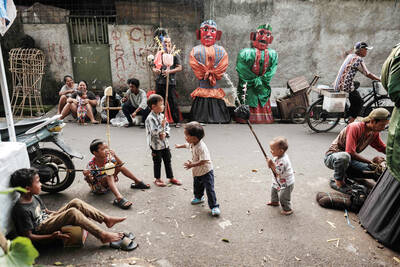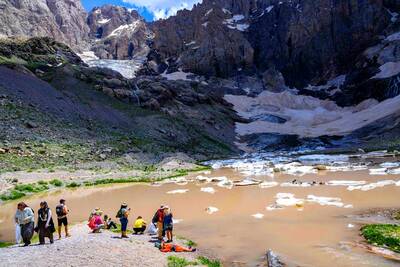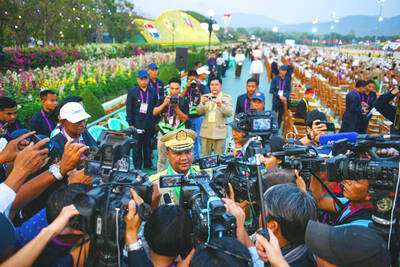Bullet holes still pockmark the walls of the house in Mexico where Russian revolutionary Leon Trotsky was brutally murdered 80 years ago, a reminder of an earlier failed assassination attempt.
“I’m already familiar” with death, Trotsky said after he survived that attack in his home in a suburb of Mexico City where he spent his last years in exile.
“I’ve been followed by the black hatred of [then-Soviet leader Joseph] Stalin across half the world,” he told a Mexican newspaper.

Photo: AFP
Months later, on Aug. 20, 1940, that trail of persecution finally caught up with him when he was killed with an ice axe by an assassin acting on Stalin’s orders.
“It was an ideological, symbolic crime,” said Cuban writer Leonardo Padura, who spent years researching the murder for his novel The Man who Loved Dogs.
Trotsky’s house in the leafy neighborhood of Coyoacan has been preserved as a museum, where his grave is marked by a tombstone engraved with a hammer and sickle in the compound.
The watchtowers, high walls and bullet holes left by Stalin’s hit squad offer insight into how the key figure in the Bolshevik Revolution spent his final days.
Born Lev Davidovich Bronstein, Trotsky was the founder of the Red Army and, along with fellow revolutionary Vladimir Lenin, one of the prime movers in the Bolshevik revolt that overthrew Tsar Nicholas II.
After falling out with Stalin in the 1920s, Trotsky was forced into exile.
The Marxist revolutionary drifted from Turkey to Norway to France before finally landing in Mexico in 1937, where the muralist Diego Rivera helped to persuade then-Mexican president Lazaro Cardenas’ government to grant him asylum.
Accompanied by his wife, Natalia Sedova, Trotsky was welcomed at the Port of Tampico by the painter Frida Kahlo, with whom it is rumored that he had an affair.
“Upon his arrival, he mixed with a group of characters who coincided in those moments in an explosive Mexico, starting with Rivera and Kahlo,” Padura said.
However, even on another continent, the revolutionary was not safe from Stalin’s regime.
Trotsky and his wife survived the first attack on May 24, 1940, by throwing themselves under their bed.
The incident led Trotsky to increase security at the compound, but it was not enough to stop his assassin, Ramon Mercader.
A Spanish communist and secret agent for the Soviet intelligence services, Mercader managed to infiltrate Trotsky’s inner circle as the lover of a New York Trotskyite.
After Trotsky installed a new metal gate at the entry to his compound controlled by guards, Mercader gave up on the idea of using a gun.
Instead the experienced mountaineer chose an ice axe, to maximize his chances of escaping.
Armed with a backup pistol and knife under his coat, he entered the compound and plunged the axe into Trotsky’s skull.
Trotsky, gravely wounded, shouted for help and Mercader was captured.
The revolutionary died at a Mexico City hospital the next day.

In the sweltering streets of Jakarta, buskers carry towering, hollow puppets and pass around a bucket for donations. Now, they fear becoming outlaws. City authorities said they would crack down on use of the sacred ondel-ondel puppets, which can stand as tall as a truck, and they are drafting legislation to remove what they view as a street nuisance. Performances featuring the puppets — originally used by Jakarta’s Betawi people to ward off evil spirits — would be allowed only at set events. The ban could leave many ondel-ondel buskers in Jakarta jobless. “I am confused and anxious. I fear getting raided or even

Kemal Ozdemir looked up at the bare peaks of Mount Cilo in Turkey’s Kurdish majority southeast. “There were glaciers 10 years ago,” he recalled under a cloudless sky. A mountain guide for 15 years, Ozdemir then turned toward the torrent carrying dozens of blocks of ice below a slope covered with grass and rocks — a sign of glacier loss being exacerbated by global warming. “You can see that there are quite a few pieces of glacier in the water right now ... the reason why the waterfalls flow lushly actually shows us how fast the ice is melting,” he said.

RISING RACISM: A Japanese group called on China to assure safety in the country, while the Chinese embassy in Tokyo urged action against a ‘surge in xenophobia’ A Japanese woman living in China was attacked and injured by a man in a subway station in Suzhou, China, Japanese media said, hours after two Chinese men were seriously injured in violence in Tokyo. The attacks on Thursday raised concern about xenophobic sentiment in China and Japan that have been blamed for assaults in both countries. It was the third attack involving Japanese living in China since last year. In the two previous cases in China, Chinese authorities have insisted they were isolated incidents. Japanese broadcaster NHK did not identify the woman injured in Suzhou by name, but, citing the Japanese

RESTRUCTURE: Myanmar’s military has ended emergency rule and announced plans for elections in December, but critics said the move aims to entrench junta control Myanmar’s military government announced on Thursday that it was ending the state of emergency declared after it seized power in 2021 and would restructure administrative bodies to prepare for the new election at the end of the year. However, the polls planned for an unspecified date in December face serious obstacles, including a civil war raging over most of the country and pledges by opponents of the military rule to derail the election because they believe it can be neither free nor fair. Under the restructuring, Myanmar’s junta chief Min Aung Hlaing is giving up two posts, but would stay at the